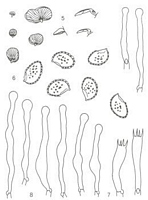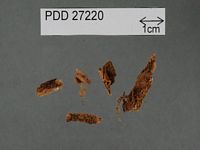|
 Pyrrhoglossum viriditinctum Pyrrhoglossum viriditinctum
BiostatusPresent in region - Indigenous. Endemic
Images (click to enlarge)
Caption: (PDD 27220, type; New Zealand): 5. basidiomes. - 6. spores. - 7. basidia. - 8. Cheilocystidia | 
Caption: Dried type specimen
Owner: Herb PDD |
Article: Horak, E. (1989). New and additional data concerning Pyrrhoglossum and eccentric or laterally stipitate taxa of Gymnopilus (Agaricales). Opera Botanica 100: 115-129.
Description: Pileus -15 mm, hemispherical, conchate or fan-shaped, convex to expanded, margin not inrolled; distinctly green (patina green to olive) when young, becoming reddish brown in old specimens with margin remaining greenish; thin, dry, not hygophanous, margin non-striate. Lamellae moderately crowded (1-7), adnate, ventricose; pale green at first, turning argillaceous, finally pale rust brown, white edge subfimbriate. Stipe -4 x -1 mm, present both in young and old specimens, eccentric or lateral, cylindrical; dark green to olive; solid, dry, smooth to minutely pruinose, single, rhizoids absent, veil remnants none. Taste and odour not distinctive. Context pale green, turning pallid in mature specimens. Chemical reactions: KOH-negative.
Spore print pale rust brown. - Spores 5.5-6.5 x 3.5-4 µm, pip shaped to subamygdaliform, rust brown, coarsely verrucose, warts embedded in well-developed perisporium, plage ± delimited, germ pore absent. Basidia 20-30 x 5 µm, 4-spored. Cheilocystidia 30-55 x 3-6 µm, lecythiform, capitate apex up to 6 µm diam., membrane thin-walled, hyaline, occasionally with (in water) greenish or (in KOH) yellow-brown plasmatic pigment. Pleurocystidia none. Caulocystidia rare, size and shape like cheilocystidia. Pileipellis composed of slender, cylindrical hyphae (-2 µm diam.), terminal cells not differentiated, membranes not gelatinised, encrusted with greenish or pale brown pigment not dissolving in KOH, interwoven hyphae in subcutis up to 6 µm diam., oleiferous hyphae absent. Clamp connections numerous.
Habitat: On rotten wood of Dacrydium cupressinum (Podocarpaceae).
Distribution: New Zealand.
Notes: The present species is a unique representative of Pyrrhoglossum significantly characterized by the complete lack of lilac colours. Instead all parts of the fresh basidiomes are consistently green to olive with the exception of the lamellae slowly turning to rust brown in mature specimens. In size and shape P. viriditinctum is likely to be taken for overmature and discoloured specimens of P. pyrrhum, which also occurs in New Zealand. The two taxa however are readily distinguished by their distinctive microscopical features.
|